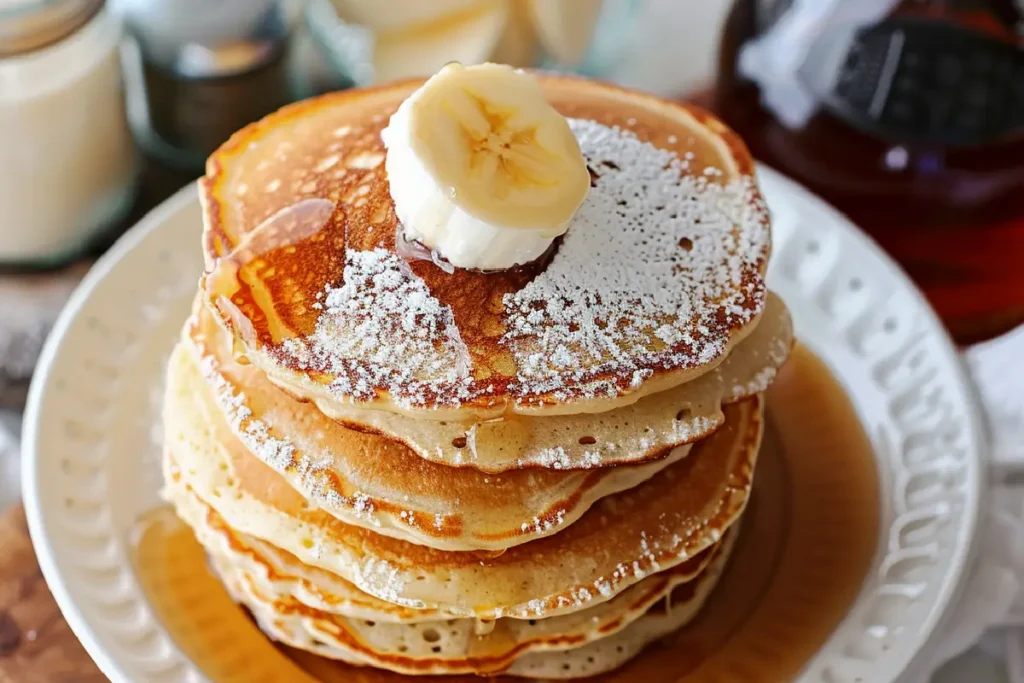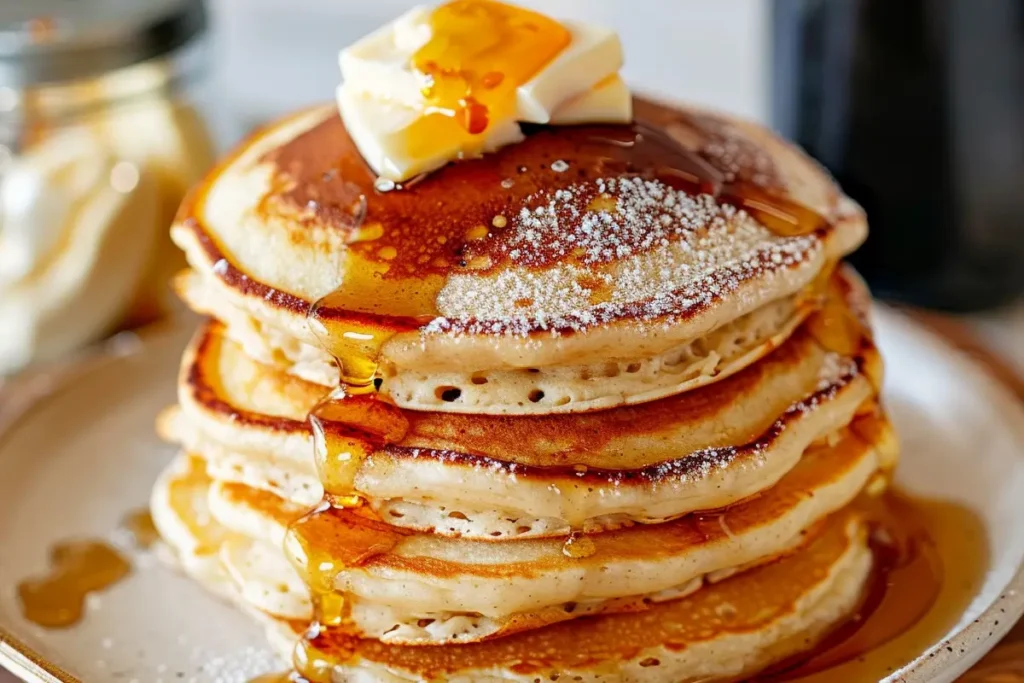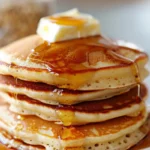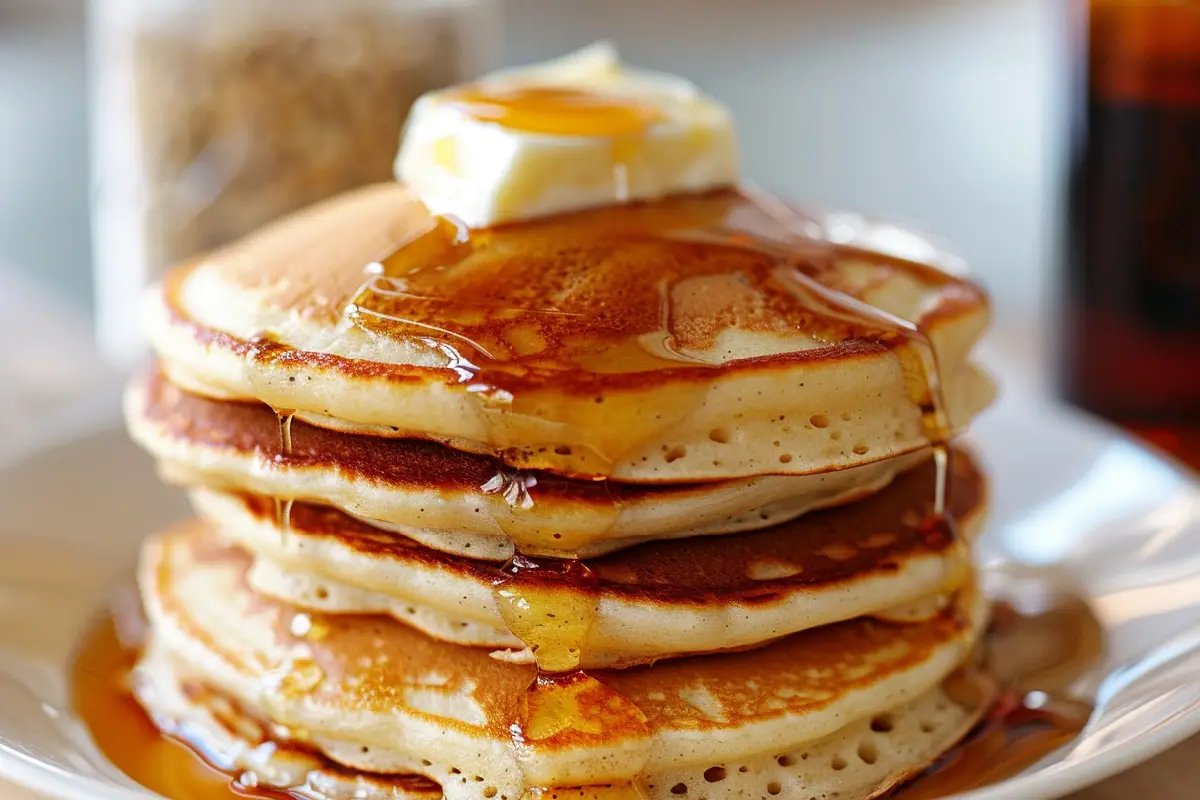Table of Contents: Can I Use Water Instead of Milk for Pancakes?
Introduction: Can I Use Water Instead of Milk for Pancakes?
Who doesn’t love a stack of fluffy, golden pancakes for breakfast? They’re warm, comforting, and the perfect canvas for syrup, fruit, or even chocolate chips. But what if you’re out of milk? Can you use water instead of milk for pancakes? The answer is yes—and with a few simple tricks, they can still be delicious!
Pancakes are one of the easiest breakfast recipes to whip up, and they’re a family favorite for a reason. Whether you’re making classic buttermilk pancakes or experimenting with dairy-free options, knowing how to adjust the recipe is key. And if you loved our 3-Ingredient Banana Pancakes, you’ll appreciate how versatile pancake batter can be!
In this guide, we’ll walk you through five easy tips to make perfect pancakes with water—no milk required. Get ready to flip the fluffiest stacks yet!
What Are Pancakes?

Ah, pancakes—those round, golden discs of joy that make mornings better. But why are they called pancakes? Well, it’s pretty straightforward: they’re cakes… made in a pan! (Mind-blowing, right?) Whether you call them flapjacks, hotcakes, or griddle cakes, one thing’s for sure: they’ve been winning over breakfast lovers for centuries.
Some say the way to a person’s heart is through their stomach, and if that’s true, pancakes must be the ultimate love language. Sweet or savory, thick or thin, they’re endlessly customizable. So, why not try making them with water this time? You might be surprised at how good they turn out!
Why You’ll Love This Recipe
✅ No Milk? No Problem! – Ran out of milk? No worries! Water works just fine with a few tweaks.
✅ Budget-Friendly – Skip the dairy and save money without sacrificing flavor.
✅ Light & Fluffy – With the right technique, your pancakes will still be soft and airy.
If you enjoy our Fluffy Buttermilk Pancakes, you’ll love this simple swap. Plus, you can still load them up with toppings like fresh berries, whipped cream, or a drizzle of maple syrup. Ready to give it a try? Let’s get flipping!
How to Make Pancakes with Water
Quick Overview
- Prep Time: 5 mins
- Cook Time: 10 mins
- Total Time: 15 mins
- Difficulty: Easy
- Servings: 8-10 pancakes
Key Ingredients
- 1 cup all-purpose flour
- 1 tbsp sugar
- 2 tsp baking powder
- ¼ tsp salt
- 1 cup water (plus extra if needed)
- 1 egg
- 1 tbsp oil or melted butter
- 1 tsp vanilla extract (optional)
Step-by-Step Instructions
- Mix Dry Ingredients – In a bowl, whisk flour, sugar, baking powder, and salt.
- Combine Wet Ingredients – In another bowl, beat the egg, then mix in water, oil, and vanilla.
- Make the Batter – Pour wet ingredients into dry ingredients and stir until just combined (small lumps are okay!).
- Rest the Batter – Let it sit for 5 mins to activate the baking powder for fluffier pancakes.
- Cook Pancakes – Heat a non-stick pan over medium heat, pour ¼ cup batter per pancake, and cook until bubbles form (about 2 mins). Flip and cook for another 1-2 mins.
What to Serve with Pancakes
- Classic: Maple syrup & butter
- Fruity: Fresh berries & whipped cream
- Indulgent: Chocolate chips & Nutella
- Savory Twist: Bacon & scrambled eggs
Top 5 Tips for Perfect Pancakes with Water
- Add Extra Flavor – Since water is neutral, enhance taste with vanilla, cinnamon, or almond extract.
- Adjust Thickness – If batter is too thick, add 1-2 tbsp more water.
- Don’t Overmix – Lumpy batter = fluffier pancakes!
- Use a Hot Pan – Prevents sticking and ensures even cooking.
- Let Batter Rest – Helps gluten relax for a tender texture.
Storing & Reheating Tips

- Fridge: Store in an airtight container for up to 2 days.
- Freezer: Layer pancakes between parchment paper and freeze for up to 1 month.
- Reheat: Microwave for 30 secs or toast for crispiness.
FAQs: Can I Use Water Instead of Milk for Pancakes?
1. Do pancakes taste different with water instead of milk?
Yes, they’ll be slightly less rich since milk adds creaminess. But with added vanilla or butter, they’ll still taste great!
2. Can I use carbonated water for fluffier pancakes?
Absolutely! The bubbles add extra lift, making them even lighter.
3. What’s the best water-to-flour ratio?
Start with 1:1 (1 cup water per 1 cup flour), then adjust if the batter is too thick.
4. Can I make vegan pancakes with water?
Yes! Replace the egg with 1 tbsp flaxseed meal + 3 tbsp water, and use oil instead of butter.
5. Why are my water-based pancakes rubbery?
Overmixing develops gluten. Stir batter gently and leave small lumps for tender pancakes.
Conclusion: Can I Use Water Instead of Milk for Pancakes?
So, can you use water instead of milk for pancakes? Absolutely! While milk adds richness, water works perfectly in a pinch—especially when you follow our five easy tips for fluffy, delicious results. Whether you’re out of milk, cutting costs, or just experimenting, this simple swap proves that great pancakes don’t always need dairy.
Now it’s your turn! Whip up a batch, pile on your favorite toppings, and enjoy a stress-free breakfast. And if you love kitchen hacks like this, don’t miss our 5-Minute Microwave Pancake recipe for even quicker mornings!
Happy flipping! 🥞
Print
Classic Pancakes
- Total Time: 15 mins
- Yield: 8–10 pancakes 1x
- Diet: Vegetarian
Description
“Fluffy, golden pancakes made with water instead of milk! Perfect for when you’re out of dairy, these easy pancakes are light, budget-friendly, and ready in 15 minutes. Top with syrup, fruit, or chocolate chips for a delicious breakfast.”
Ingredients
- 1 cup all-purpose flour
- 1 tbsp sugar
- 2 tsp baking powder
- ¼ tsp salt
- 1 cup water (adjust as needed)
- 1 large egg
- 1 tbsp vegetable oil or melted butter
- 1 tsp vanilla extract (optional)
Instructions
- Mix dry ingredients: Whisk flour, sugar, baking powder, and salt in a bowl.
- Combine wet ingredients: In another bowl, beat egg, then stir in water, oil, and vanilla.
- Make batter: Pour wet ingredients into dry ingredients. Stir until just combined (small lumps are okay).
- Rest batter: Let sit 5 minutes for fluffier pancakes.
- Cook: Heat a non-stick pan over medium heat. Pour ¼ cup batter per pancake. Cook until bubbles form (2 mins), flip, and cook 1–2 more minutes.
Notes
- Flavor boost: Add cinnamon or almond extract for extra taste.
- Vegan option: Replace egg with 1 tbsp flaxseed meal + 3 tbsp water.
- Freezing: Layer cooked pancakes between parchment paper; freeze for up to 1 month.
- Prep Time: 5 mins
- Cook Time: 10 mins
- Category: Breakfast, Brunch
- Method: Stovetop
- Cuisine: American
Nutrition
- Serving Size: 1 pancake
- Calories: 90 kcal
- Sugar: 2g
- Sodium: 150mg
- Fat: 3g
- Saturated Fat: 0.5g
- Unsaturated Fat: 2g
- Trans Fat: 0g
- Carbohydrates: 14g
- Fiber: 0.5g
- Protein: 2g
- Cholesterol: 20mg
Keywords: pancakes, easy pancakes, no-milk pancakes, fluffy pancakes

